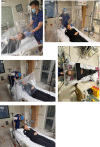Measurement of airborne particle exposure during simulated tracheal intubation using various proposed aerosol containment devices during the COVID-19 pandemic
- PMID: 32559315
- PMCID: PMC7323428
- DOI: 10.1111/anae.15188
Measurement of airborne particle exposure during simulated tracheal intubation using various proposed aerosol containment devices during the COVID-19 pandemic
Abstract
The COVID-19 pandemic has led to the production of novel devices intended to protect airway managers during the aerosol-generating procedure of tracheal intubation. Using an in-situ simulation model, we evaluated laryngoscopist exposure of airborne particles sized 0.3 - 5.0 microns using five aerosol containment devices (aerosol box; sealed box with and without suction; vertical drape; and horizontal drape) compared with no aerosol containment device. Nebulised saline was used as the aerosol-generating model for 300 s, at which point, the devices were removed to assess particle spread. Primary outcome was the quantity and size of airborne particles measured at the level of the laryngoscopist's head at 30, 60, 120 and 300 s, as well as 360 s (60 s after device removal). Airborne particles sizes of 0.3, 0.5, 1.0, 2.5 and 5.0 microns were quantified using an electronic airborne particle counter. Compared with no device use, the sealed intubation box with suction resulted in a decrease in 0.3, 0.5, 1.0 and 2.5 micron, but not 5.0 micron, particle exposure over all time-periods (p = 0.003 for all time periods). Compared with no device use, the aerosol box showed an increase in 1.0, 2.5 and 5.0 micron airborne particle exposure at 300 s (p = 0.002, 0.008, 0.002, respectively). Compared with no device use, neither horizontal nor vertical drapes showed any difference in any particle size exposure at any time. Finally, when the patient coughed, use of the aerosol box resulted in a marked increase in airborne particle exposure compared with other devices or no device use. In conclusion, novel devices intended to protect the laryngoscopist require objective testing to ensure they are fit for purpose and do not result in increased airborne particle exposure.
Keywords: COVID-19; PPE; aerosol box; barrier device; intubation; particle counts; personal protective equipment.
© 2020 Association of Anaesthetists.
Figures




Comment in
-
Measurement of airborne particle exposure during simulated tracheal intubation using various proposed aerosol containment devices during the COVID-19 pandemic.Anaesthesia. 2021 Mar;76 Suppl 3(Suppl 3):7-8. doi: 10.1111/anae.15227. Epub 2020 Aug 1. Anaesthesia. 2021. PMID: 32737982 Free PMC article. No abstract available.
References
MeSH terms
Substances
LinkOut - more resources
Full Text Sources
Medical

